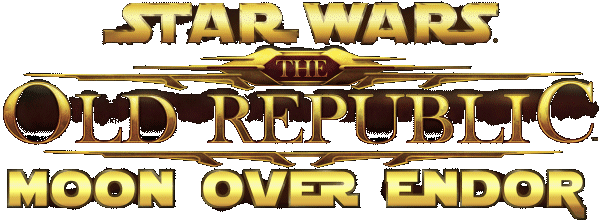First of all there's the third part of the Threat of Peace comic, clearly keeping to its bi-weekly schedule. Here's the official news:
In this we get some lightsaber combat, an explosion and betrayal at the diplomat's table. But while the comic is enjoyable to read, the better news this week is the first installment of the The Old Republic timeline, detailing events leading up to the game. Here's the official news:The third issue of Threat of Peace™ reveals the conclusion of the confrontation between Lord Angral and Jedi Master Orgus Din on Coruscant. As Lord Angral proceeds with his ruthless agenda, a desperate transmission is sent to interrupt the peace talks on Alderaan. Even as the grim reality of the situation becomes clear to Republic and Jedi leaders attending the talks, hope dwindles for the defense of Coruscant.
Check out the latest issue of Threat of Peace now.
Yes, you read that right; Lance Henriksen.Star Wars™: The Old Republic™ is set during a unique time period in the galaxy’s history. Decades of war concluded with the Sith Empire sacking the Republic’s capital planet, Coruscant, and forcing Republic Senators and the Jedi Council to agree to a painful peace treaty.
In the years following the treaty, the Jedi Council tasked Master Gnost-Dural, Keeper of the Jedi Archives, with re-examining the galaxy’s history in light of recent events. In his insightful reports, Master Gnost-Dural established a new galactic timeline that became an educational reference for years to come… the very same years in which Star Wars: The Old Republic takes place.
In his first entry, Master Gnost-Dural recounts the events immediately prior to the signing of the Treaty of Coruscant – the turning point in the Republic’s recent history.
Watch Timeline 1: The Treaty of Coruscant narrated by actor Lance Henriksen.
Before I read that last line I was expecting a written article with perhaps some images in it or such. But it's actually a movie (consisting of concept art) narrated by the famous actor. And it seems that they built a special interface for the timeline movies including a text description and a 'timeline' detailing the various entries (though only this first one is active). From the looks of it the future timeline updates will go increasingly further back in the past, which makes sense as they wouldn't want to spoil the start of the game.
And just because I can, here's the text spoken by Mr. Henriksen:
GREETINGS. I AM MASTER GNOST-DURAL, KEEPER OF THE JEDI ARCHIVES.Based on the final comment (and the image shown with it in the video) as well as one of the timeline entry descriptions (talking about "a smuggler convoy") it's fairly certain that one of the Republic classes yet to be revealed will be the Smuggler. Which makes sense as this would be the Han Solo archetype. The timeline also makes mention of "imperial intelligence" which might suggest yet another class (it's been speculated that the balancing class for Smuggler might be some kind of Imperial Spy). But that's reading a lot into very little.
THE JEDI COUNCIL REQUESTS I PERFORM A DAUNTING TASK—TO REVISE THE ORDER’S HISTORICAL RECORDS IN LIGHT OF NEW REVELATIONS ABOUT THE FORMATION OF THE SITH EMPIRE.
I AM SPECIFICALLY GUIDED TO TRACE BACK THE CONFLICT BETWEEN THE EMPIRE AND THE REPUBLIC, THE SITH AND THE JEDI, AND UNCOVER THE ROOTS OF THE STRUGGLE WHICH PLAGUES OUR TIME.
I'VE CHOSEN TO BEGIN WITH THE SINGULAR DEFINING EVENT OF RECENT YEARS—THE UNPRECEDENTED PEACE AGREEMENT BETWEEN THE SITH EMPIRE AND THE GALACTIC REPUBLIC—THE TREATY OF CORUSCANT.
IT WAS THREE CENTURIES AFTER THE DEATH OF DARTH MALAK AND THE END OF THE JEDI CIVIL WAR THAT THE TRUE SITH EMPIRE FIRST RETURNED FROM DEEP SPACE, ATTACKING THE REPUBLIC AND BEGINNING A WAR UNLIKE ANY OTHER IN THE GALAXY’S HISTORY.
THE GREAT GALACTIC WAR DRAGGED ON FOR DECADES. HUNDREDS OF JEDI AND SITH WERE SLAIN, AND COUNTLESS STAR SYSTEMS RAVAGED.
DESPITE SEIZING CONTROL OF HALF THE GALAXY, THE SITH EMPEROR GREW IMPATIENT—HE HAD EXPECTED HIS TRIUMPH TO COME QUICKLY.
THE LORDS OF THE EMPEROR’S DARK COUNCIL SURPRISED THE REPUBLIC SENATE WITH AN OFFER OF PEACE—A REPRIEVE THE REPUBLIC COULD NOT AFFORD TO IGNORE.
THE REPUBLIC’S MOST CRITICAL TRADE ROUTE WAS STILL RECOVERING FROM A MANDALORIAN BLOCKADE, WHICH SLOWED THE TRANSPORT OF MILITARY SUPPORT TO THE OUTER RIM AND RAW MATERIALS TO THE CORE WORLDS.
THE JEDI COUNCIL URGED THE SENATE TO CONSIDER THE SITH’S OFFER WITH CAUTION, BUT EVEN THE JEDI HAD TO AGREE—THE WAR WAS UNWINNABLE—PEACE WAS THE ONLY HOPE.
REPUBLIC AND IMPERIAL DIPLOMATS CONVENED ON THE PLANET OF ALDERAAN TO DISCUSS A GALAXY-WIDE CEASE-FIRE…
BUT THE SITH STILL HAD ONE PLAY TO MAKE.
THE IMPERIAL FLEET LAUNCHED A SURPRISE ASSAULT, BOMBARDING THE REPUBLIC CAPITAL OF CORUSCANT FROM ORBIT AND THEN STORMING THE CITY-WORLD’S BOTTOMLESS TOWERS.
WITH CORUSCANT’S DEFENSES INCAPACITATED, THE IMPERIALS ANNIHILATED THE JEDI TEMPLE, CAPTURED THE SENATE TOWER, AND HELD THE ENTIRE PLANET HOSTAGE.
BACK ON ALDERAAN, REPUBLIC DIPLOMATS HAD NO CHOICE. DESPITE UNFAVORABLE TERMS, THE TREATY OF CORUSCANT WAS SIGNED.
JEDI AND REPUBLIC TROOPS BEGAN WITHDRAWING FROM BATTLEFIELDS AROUND THE GALAXY, LEAVING STAR SYSTEMS TO FEND FOR THEMSELVES AND TO BE QUICKLY SWALLOWED UP BY THE SITH EMPIRE.
THE JEDI RETURNED TO CORUSCANT TO FIND THEIR TEMPLE IN RUINS AND IRATE SENATORS BLAMING THE JEDI ORDER FOR ALL THE REPUBLIC’S TROUBLES.
THOUGH STILL COMMITTED TO DEFENDING THE REPUBLIC, THE JEDI RELOCATED TO THEIR ANCIENT HOMEWORLD OF TYTHON—THERE TO REST, MEDITATE, AND SEEK GUIDANCE FROM THE FORCE.
THUS BEGAN AN UNPRECEDENTED STALEMATE—THE JEDI RECONNECTING WITH THEIR ROOTS, THE REPUBLIC NURSING ITS WOUNDS, THE SITH CONSOLIDATING THEIR POWER, AND A GALAXY DIVIDED BETWEEN DARKNESS AND LIGHT.
IN RETROSPECT, THIS OUTCOME WAS INEVITABLE, AND WOULD HAVE COME SOONER WERE IT NOT FOR SOME OF THE REPUBLIC'S LESS SAVORY ALLIES. I WILL ELABORATE ON THIS THEORY SOON.
Either way a very exciting update, better than I was expecting after the two previous great updates.







